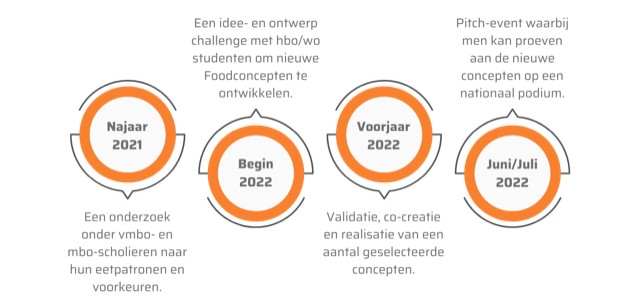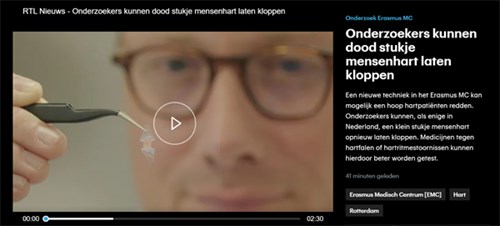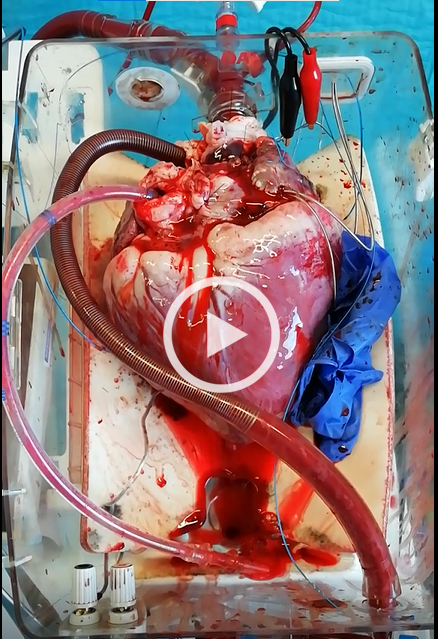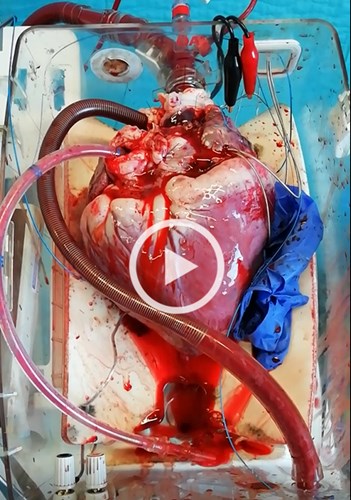A team of researchers involved in the scientific program Medical Delta Cardiac Arrythmia Lab has created a research setup at Erasmus MC that keeps slices of human heart tissue alive in a biomimetic system. This allows the team, led by Dr. Yanick Taverne, to see the effect of medication or treatments on specific patients in a very targeted way and for a longer period of time. It also allows them to better investigate common conditions such as cardiac arrhythmia and its causes.
Click here to watch the report of RTL Nieuws of Friday, August 6 (in Dutch).
This is the first time in The Netherlands that research has been conducted in this way, with living human heart tissue that is residual from heart surgery. The scientists hope to gain a more accurate picture of how cells communicate with each other and how heart failure and cardiac arrhythmia can be treated, but also how patients have the best chance of a properly functioning heart after a heart transplant.
The set-up at Erasmus MC is led by Dr. Yanick Taverne, heart transplant surgeon, head of the Translational Cardiothoracic Surgery Reserach Lab, and one of the principal investigators within the scientific program of Medical Delta Cardiac Arrythmia Lab. In this program, scientists from various disciplines work together: from technologists and medical scientists to data analysts and even an astronomer. The set-up has been operational for six months now and the first measurements have been successful. Taverne's research focuses on the link between excitation (electrical impulse) and the subsequent contraction, which can be disturbed in patients with heart failure.
Measuring excitation-contraction coupling in living heart muscle tissue
One of the ongoing studies within the Medical Delta program involves measurements of electrical conductivity during normal heart rhythm and heart rhythm disorders. During open-heart surgery, electrodes designed by TU Delft are placed on the heart for a short time. Using mapping techniques, the researchers look at the causes and the course of the arrhythmia. The ultimate goal is to improve the treatment of cardiac arrhythmia.
The residual tissue from the operation of patients in which electrical measurements have been taken, can be cultivated in the set-up in the lab. There, measurements can then be taken over a longer period of time to determine the connection between electrical signals from the heart and the contraction of the tissue. It is also possible to measure in 'real time' how the contraction proceeds and how this changes when certain actions are taken, such as making the heart tissue beat faster or supplying less oxygen. In this way, the researchers hope to gain a better understanding of the causes and consequences of cardiac arrhythmia, and to detect possible defects that cause heart failure or heart rhythm disorders.
In addition, Dr. Taverne and his team hope to gain more insight into the effect of medication or treatment for specific patients. Ultimately, this could lead to more personalized treatments, in which a treatment or medication is first applied to the living piece of tissue that was previously taken from a patient.
'Pimping' the donor heart
Besides human heart tissue, the lab also houses a set-up to reboot pig hearts from the slaughterhouse (see video below). Since pig hearts are almost identical to human hearts, this may provide new insights into the preparation of a human heart that is destined for transplantation in such a way that it functions optimally in another body. Dr. Taverne is trying to improve the contraction of these beating pig hearts by detecting and repairing any trauma or defects.
The researchers expect to bring out the first scientific publications next year.
Read here another article about this research on Amazing Erasmus.




